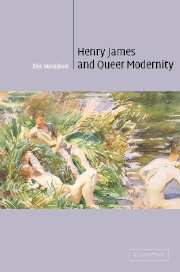Book contents
- Frontmatter
- Contents
- Acknowledgments
- List of abbreviations
- Introduction
- 1 Indiscreet anatomies and protogay aesthetes in Roderick Hudson and The Europeans
- 2 The elusive queerness of “queer comrades”: The Tragic Muse and “The Author of ‘Beltraffio’”
- 3 The Turn of the Screw, or: The Dispossessed Hearts of Little Gentlemen
- 4 Masculinity “changed and queer” in The Ambassadors
- 5 Gratifying “the eternal boy in us all”: Willa Cather, Henry James, and Oscar Wilde
- 6 “The other half is the man”: the queer modern triangle of Gertrude Stein, Ernest Hemingway, and Henry James
- Coda: “Nobody is alike Henry James.” Stein, James, and queer futurity
- Notes
- Bibliography
- Index
2 - The elusive queerness of “queer comrades”: The Tragic Muse and “The Author of ‘Beltraffio’”
Published online by Cambridge University Press: 22 September 2009
- Frontmatter
- Contents
- Acknowledgments
- List of abbreviations
- Introduction
- 1 Indiscreet anatomies and protogay aesthetes in Roderick Hudson and The Europeans
- 2 The elusive queerness of “queer comrades”: The Tragic Muse and “The Author of ‘Beltraffio’”
- 3 The Turn of the Screw, or: The Dispossessed Hearts of Little Gentlemen
- 4 Masculinity “changed and queer” in The Ambassadors
- 5 Gratifying “the eternal boy in us all”: Willa Cather, Henry James, and Oscar Wilde
- 6 “The other half is the man”: the queer modern triangle of Gertrude Stein, Ernest Hemingway, and Henry James
- Coda: “Nobody is alike Henry James.” Stein, James, and queer futurity
- Notes
- Bibliography
- Index
Summary
The scene [of The Tragic Muse] will be in London … in a very different monde, considerably the “Aesthetic” … It won't be improper; strange to say, considering the elements.
(Henry James, Letters, 1888)Was Gabriel Nash vice? Was Mrs. Dallow virtue?
(William Dean Howells, review of The Tragic Muse, 1890)This chapter centers on The Tragic Muse, James's 1890 novel about the artistic vocation and the fate of art in a debasing material world, taking a special interest in the character of Gabriel Nash, by common consent the premier “Oscar Wilde figure” in the Jamesian canon. In a way that bears watching, Nash himself consistently thwarts the efforts of others to fix the label “aesthete” (or any other) upon him: “Ah, there's one of the formulas ! That's walking in one's hat !” (TM 27). Nash's point is not that he is not an aesthete, since he clearly fits the mold, but rather that the attribution can scarcely be benign, since it participates in a reductive logic of specification that seeks to taxonomize social identities and, if possible, to control them. James's diffuse novel follows the development of two artistic aspirants, Miriam Rooth, who eventually conquers the London stage by exercising the “unscrupulous … wanton” willpower of the born artist, and Nicholas Dormer, who violates “innumerable vows and pledges” of family tradition by renouncing a career in Parliament for one in portrait painting (TM 240, 298).
- Type
- Chapter
- Information
- Henry James and Queer Modernity , pp. 54 - 78Publisher: Cambridge University PressPrint publication year: 2003



